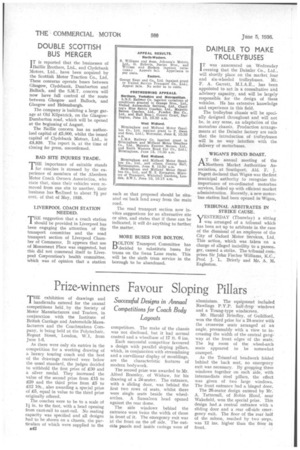Prize-winners Favour Sloping Pillars
Page 52

If you've noticed an error in this article please click here to report it so we can fix it.
Successful Designs in Annual Competitions for Coach Body Layouts
THE exhibition of drawings and handicrafts entered for the annual competitions held, by the Society of Motor Manufacturers and Traders, in conjunction with the Institute of British Carriage and Automobile Manufacturers and the Coachmakers Company, is being held at the Polytechnic, Regent Street, London, W.1, from June 1-6.
As there were only six entries in the competition for a working drawing of a luxury touring coach and the best of the drawings received were below the usual standard, the judges decided to withhold the first prize of £30 and a silver medal. They increased the value of the second prize from £15 to 2.20 and the third prize frOm £5 to £12 10s,, also awarding a special prize of £5, equal in value to the third prize originally offered.
The coaches were to be to a scale of 1i in. to the foot, with a head opening from cant-rail to cant-rail. No seating capacity was specified and all designs had. to be shown on a chassis, the particulars of which were supplied to the
n42
competitors. The make of the chassis was not disclosed, but it had normal control and a wheelbase of 17 ft. 6 ins.
Each successful competitor favoured a design with parallel sloping pillars, which, in conjunction with streamlining and a curvilinear display of mouldings, are the characteristic features of modern bodywork.
The second prize was awarded to Mr. Alfred Bramley, of Wishaw, for his drawing of a 24-seater. The entrance, with a sliding door, was behind the first two rows of seats, whilst there were single seats beside the wheelarches. A Sunealoon head opened against the rear dome.
The side windows behind the entrance were twice the width of those in front of it. The emergency exit was it the front on the off side. The outside panels and inside casings were of aluminium. The equipment included Rawlings P.Y.P. half-drop windows and a Young-type windscreen.
Mr. Harold Brindley, of Guildford, won the third prize for a 24-seater with the crosswise seats arranged at an angle, presumably with a view, to increasing the width of the central gangway at the front edges of the seats: The leg room of the wheel-arch seats appeared to be somewhat cramped.
As the Triumf-ed headwork folded behind the back seat, no emergency exit was necessary. By grouping three windows together on each side, with intermediate steel pillars, the effect was given of two large windows. The front entrance had a hinged door.
The 26-seater design entered by Mr.' A. Tattersall, of Robin Hood, near Wakefield, won the special prize. This design had a central entrance with a sliding door and a rear off-side emergency exit. The floor of the rear half of the saloon, reached by two steps, was 12 ins, higher than the floor in front.




















































































